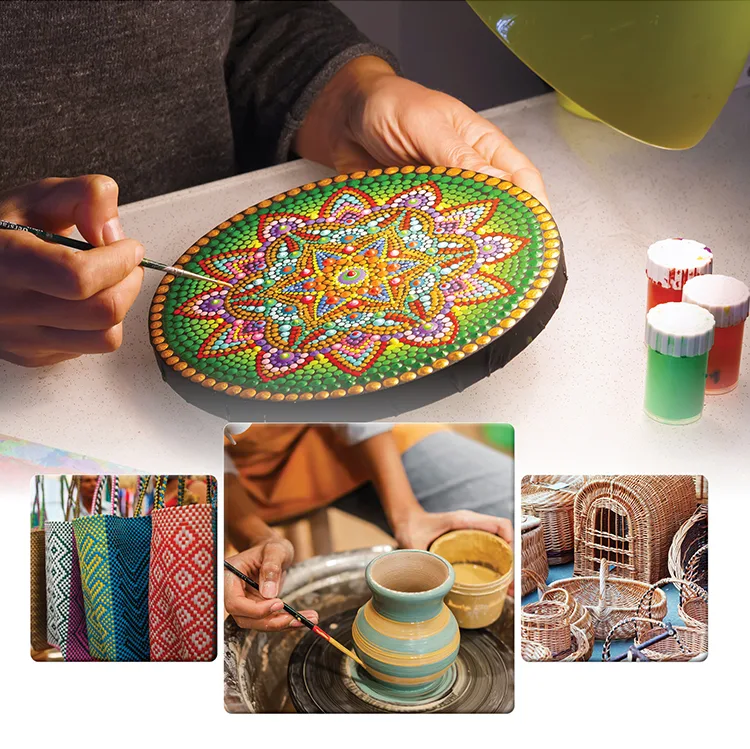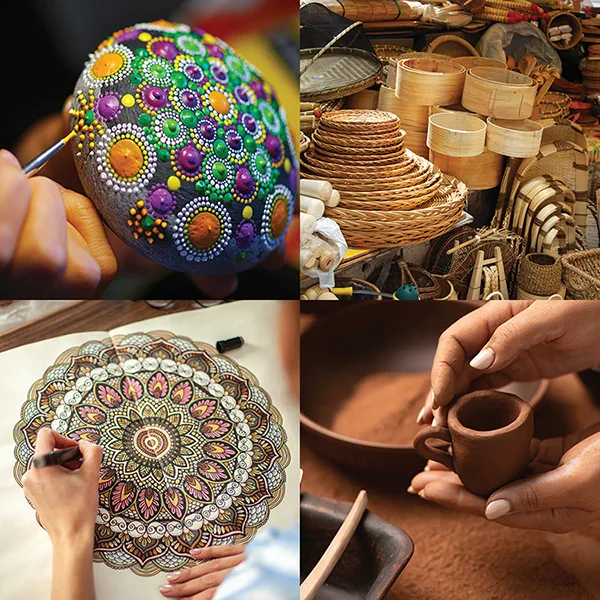A handicraft business centers around creating and selling handmade items that are both functional and aesthetic. These businesses thrive on individual skill, artistic creativity and the uniqueness of handmade items, distinguishing them from mass-produced goods.
Handicraft businesses offer a wide range of products, including textiles (woven or embroidered clothing, blankets), decorative items (pottery, sculptures, paintings), jewelry, leather goods, woodcrafts, metal crafts and more.
A key aspect of the handicraft business is its deep connection with culture and tradition. Many artisans incorporate traditional techniques, motifs and stories into their products, making each piece unique and often tied to a specific cultural or regional context.
The digital revolution has significantly impacted the handicraft business. While the craft itself remains deeply tactile and physical, the reach of these businesses has expanded enormously through online selling platforms, digital marketing, and e-commerce.
In essence, a handicraft business is a vibrant blend of tradition and innovation, offering unique and personalized products to customers while allowing artisans to sustain their craft, generate income and contribute to the cultural richness of society.
Success in the handicraft business requires passion, skills and a comprehensive understanding of the business landscape. Embarking on this journey in India? Here’s how to begin:
How to Start a Handicraft Business in India
Identifying Your Craft
Before setting up your handicraft business, identify the type of craft that you want to sell. It should ideally be a mix of your skills and interests, market demand and distinctiveness.
Creating a Business Plan
Create a comprehensive business plan that includes your target market, financial projections, marketing strategies and growth plans. This plan will serve as a roadmap for your venture.
Legal Formalities
To legally establish your business in India, obtain necessary registrations and licenses. These may include GST registration, business entity registration (sole proprietorship, partnership, etc.), and a trade license.
Arranging Finance
Initial investment will cover the cost of raw materials, workspace and marketing. Various government schemes and banks provide financial assistance to small businesses in India.
Production Process
Set up a production process. This involves sourcing raw materials, establishing a workspace and deciding on the production scale.
Marketing and Selling
Develop effective marketing strategies to reach your target audience. Choose suitable sales channels like e-commerce platforms, local exhibitions or a dedicated website.

Understanding the Handicraft Business
A handicraft business involves creating and selling handmade goods, ranging from decorative jewelry and textiles to furniture and much more. It is unique because it centers on personal creativity and craftsmanship, providing consumers with a refreshing alternative to mass-produced items.
Discover Profitability in the Handicraft Business
The handicraft business holds immense potential for profitability due to the following reasons:
- High demand for unique, handmade products
- Low initial investment compared to other businesses
- Easy to scale and expand
- Opportunities for both domestic and international sales
The profitability depends on factors like the uniqueness of products, pricing strategy, marketing and sales channels. With effective strategies, one can generate substantial income.
| Type of Handicraft | Estimated Monthly Sales Volume | Average Price Per Unit (INR) | Estimated Gross Earnings (INR) |
|---|---|---|---|
| Textile Crafts (clothing, embroidery, etc.) | 100 Units | ₹3750 | ₹3,75,000 |
| Decorative Crafts (pottery, sculptures, etc.) | 80 Units | ₹5625 | ₹4,50,000 |
| Jewelry Crafts | 200 Units | ₹2250 | ₹4,50,000 |
| Paper Crafts (cards, stationery, etc.) | 300 Units | ₹750 | ₹2,25,000 |
| Wood and Metal Crafts (furniture, carvings, etc.) | 50 Units | ₹7500 | ₹3,75,000 |
Types of Handicrafts to Explore
The handicraft industry boasts an array of categories. Some popular types of handicrafts are:
- Textile-Based Handicrafts: Includes weaving, printing, embroidery, etc.
- Wood, Bamboo, Cane and Grass Handicrafts: Carving, furniture, basketry, etc.
- Leather Handicrafts: Products like bags, shoes, belts, etc.
- Stone Handicrafts: Jewelry, sculptures and decorative pieces.
- Metal Handicrafts: Jewelry, utensils, decorative items, etc.
Choose a type that resonates with your skills and market demand.
The Promise of Handicraft Business in India
India’s handicraft sector is a significant part of its cultural heritage, contributing notably to the economy. The key factors that make handicraft business promising in India are:
- Rich Tradition: India has a diverse range of traditional crafts, attracting domestic and global consumers.
- Government Support: Indian government initiatives promote the handicraft sector.
- High Demand: Rising demand for Indian handicrafts in international markets.
- E-commerce Boost: Online platforms have amplified the reach of Indian handicrafts.

Innovative Handicraft Business Ideas
While there are several handicraft business ideas, here are a few innovative ones:
- Eco-Friendly Crafts: Capitalize on the growing demand for eco-friendly products. Consider items like bamboo cutlery, jute bags, etc.
- Personalized Crafts: Offering personalized handmade products like custom jewelry, monogrammed towels, etc.
- Digital Crafts: Explore digital arts like graphic design, digital portraits, printable planners, etc.
- Upcycled Crafts: Create and sell products made from recycled or waste materials.
- DIY Craft Kits: Sell kits with instructions and materials for customers who enjoy making crafts themselves.
Essential Online Handicraft Courses
Looking to elevate your handicraft business skills? ffreedom app got your back! Their handicraft business course provides thorough insights into running a successful business in this sector. But that’s not all. With a mission to empower, ffreedom app offers a plethora of courses spanning business, farming, and personal finance. Their multilingual approach makes learning accessible to all, regardless of language barriers. So why wait? Kickstart your entrepreneurial journey with ffreedom app today.
To boost your handicraft business success, consider these online courses:
- Handicraft Business Course: A comprehensive course covering all aspects of handicraft business.
- Starting a Global Business from Village: Learn how to turn your local craft into a global enterprise.
Enroll now to master your craft and business skills! Download ffreedom app now.



